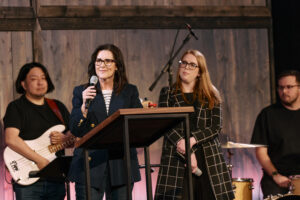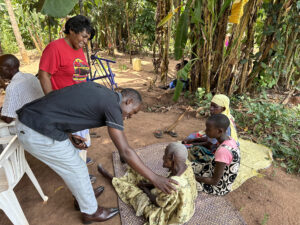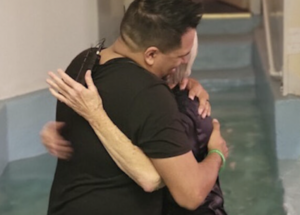
EDITOR’S NOTE: April 11 is Cooperative Program Sunday in the churches of the Southern Baptist Convention. This article is adapted in large part from the video, “Cooperative Program: A Sacred Effort.”
NASHVILLE, Tenn. (BP)–From the founding of the convention in 1845, Southern Baptists have united around a mission of “eliciting, combining, and directing the energies of the whole denomination in one sacred effort, for the propagation of the Gospel.” What was elusive in the early years was an organized plan to accomplish this mission.
At the outset, Southern Baptists simply adopted a “societal method” of financing the Convention’s ministries. In this type of support system, societies are formed and individuals most in sympathy with them are enlisted, both to work in the ministry and contribute financially, or to generate contributions from contacts in their networks of friends and social and professional circles. Campus Crusade, Prison Fellowship, Samaritan’s Purse and Youth with a Mission are all examples of ministries which traditionally have been funded by the societal method.
INDIVIDUAL EFFORT
Employing the “societal method,” Southern Baptists launched and grew various denominational ministries and institutions and went about seeking contributions from individual congregations to sustain ongoing work. Sunday after Sunday, fundraisers from seminaries and colleges, orphanages and hospitals, mission boards and benevolent organizations fanned out among Southern Baptist churches asking the faithful for help. The most gifted orator often was the most successful in securing financial support for their entity or agency — and the constant parade of ministry representatives making direct appeals took away “pulpit time” for the local pastor to preach God’s Word.
Frustration and competition were the rule.
Moreover, the results were at best ineffective and in the end created a feast and famine cycle that was bankrupting SBC cooperative ministries.
For nearly 80 years, Southern Baptists endured this “direct-appeal” approach which:
— gave more visible ministries a disproportionately large share of the offerings and left other important ministries begging.
— was unpredictable, and as the number of ministries proliferated, financial support was diluted.
— undermined the trust of Southern Baptists in this type of support system (the cost of raising money was sometimes as much as 50 percent of the proceeds).
Shortly after the turn of the 20th century, Southern Baptists knew they had to do something differently.
CAMPAIGN FAILURE
In 1919, Southern Baptists embraced a solution that fell short of its goals, but that contained key building blocks for cooperation and stability in funding. One member was selected from each of the convention’s 14 affiliated states to form a Financial Campaign Committee for raising $75 million over five years. Quotas were set for each state, and expected proceeds were budgeted out for each SBC entity, as well as for state concerns, such as colleges, orphanages and hospitals.
There was a truly unified effort on state and national levels to make it work, and Southern Baptists pledged to give over $92.6 million. But the campaign ultimately failed to reach even its original goal of $75 million in contributions. Despite strong leadership, planning and organization, the downturn in the U.S. economy resulted in only $58.6 million being collected. This was a record amount of money, but the entities of the convention had borrowed money against the pledges in anticipation of the campaign’s success and consequently were left with a huge debt. People were discouraged at the inability to fulfill their pledges, and the convention was in danger of bankruptcy.
The dream of “eliciting, combining, and directing the energies of the whole denomination” seemed to evaporate.
COOPERATIVE PROGRAM SUCCESS
In 1923, facing desperate circumstances, the Southern Baptist Convention found itself forced to regroup. The convention commissioned M.E. Dodd of Louisiana to lead a group called the “Committee on Future Program” to come up with a solution.
Borrowing the elements of coordination, uniformity and proportionate distribution from the 75 Million Campaign, the committee focused on developing an overall strategy that would produce consistent, long-lasting results.
Two years later, in Memphis, Tenn., during the SBC annual meeting, the committee announced the “Co-Operative Program of Southern Baptists.”
“While we recognize the right of individuals and churches to designate their gifts, we urge most insistently that contributions be made to the whole program and that pastors and denominational representatives and all others of our workers present the whole program and impress upon the people the importance of unity in its support. Gifts made to special objects should be over and above a liberal support of the Co-Operative Program….”
The structure of the proposed Cooperative Program was remarkably simple in design:
— Churches were to canvass their members in the fall asking for their giving pledges for the following year so that churches could set their own annual budgets.
— Out of their respective budgets, cooperating churches were to commit a percentage to give through the Cooperative Program. That percentage of revenue would then be sent on to the state convention office on a monthly basis.
— These combined resources would provide the budget base for state conventions which would send a portion of these Cooperative Program gifts on to the Southern Baptist Convention for a distribution which would address the needs of the national ministries proportionately.
The biblical principle of cooperation was the key.
At each step, participation was to be voluntary, with levels of giving and distribution to be determined by God’s leading. The plan called for each individual to prayerfully determine the level of his or her own stewardship. The combined members of each church would then pray over and vote as a congregation to approve the level of the church’s participation. Each state convention would do the same, and the national denomination would follow that same model in its meeting, approving an annual budget and determining an appropriate allocation for each of its approved ministries.
Though income might vary from one region or time period to the next, the hope was that the flow of financial support might be evened out and made more dependable as resources were combined and distributions were adjusted. And the regular nature of the collection was seen as being in keeping with the biblical mandate to give to God weekly, and in proportion to His blessing. Everyone could participate, responding to God’s call on their lives to be good stewards, and all vital ministries could depend on a consistent financial flow, thus having more time to spend on their core assignments rather than raising support.
It took time for the new idea to take hold.
Yet, though not everyone accepted the Cooperative Program at first and not all churches participate, in the very first year of its existence, Southern Baptist churches voluntarily contributed an average of nearly 11 percent of their annual budget income to this bold new integrated plan for reaching people through cooperative ministries and missions.
THE LEGACY CONTINUES
The simplicity and effectiveness of the Cooperative Program have continued to be its hallmarks, and now, the better part of a century after its birth, the Cooperative Program still functions essentially the same way it did in its earliest days. However, the success of the Cooperative Program has enabled the expansion of Southern Baptists’ missions and ministries at home and abroad in ways unforeseen in those early years.
The Cooperative Program sends doctors and nurses to show the love of Jesus to AIDS victims in Uganda. It sends agricultural missionaries to tell Ethiopians about “Living Water” while showing them how to dig wells and plant crops. It sends volunteers to paint public schools in New York City, and repair thousands of inner-city houses all across America while providing a witness of God’s ability to transform the home. Through Cooperative Program ministries, volunteer disaster relief teams are some of the first responders to areas of weather-related or other crisis, making the Southern Baptist Convention one of the largest disaster relief organizations in the world. And in every building project, every medical outpost, every cleanup, every repair, every relocation effort, every initiative and every response of every kind, Southern Baptists take the opportunity to tell how faith in Jesus Christ can make all things new.
Importantly, in response to God’s command to minister among believers and the lost, Southern Baptists have been obedient to employ the biblical concept of cooperation that infused New Testament churches internally (Acts 2:40-47; Acts 4:30-37) and catalyzed their joint missions (Acts 8: 4-8, 14-17), ministries (1 Corinthians 16:2; Romans 15:24-29) and doctrinal education (Colossians 4:16-17).
Today the Cooperative Program stands at a crossroads that it has faced before.
In 1924, M.E. Dodd, chairman of the Committee on Future Program that would recommend the Cooperative Program to Southern Baptists just one year later, spoke almost prophetically to the issues faced today:
“At this point our Unified Program will either break or be saved.
“If it should break at this point, by an under-emphasis upon the whole program and an over-emphasis upon the individual object, then we will find ourselves back where we were five years ago, with every object contending for all it can obtain, to the exclusion of other equally worthy commitments.”
In unity, Southern Baptists came together in those early years to forge the Cooperative Program.
Southern Baptists have the opportunity today to preserve and even elevate the Cooperative Program as that primary means of support and the key unifying method for showing love in action in seeking to fulfill God’s Great Commission at home and abroad.
–30–
Compiled by Baptist Press executive editor Will Hall. For more information and resources relating to the Cooperative Program, go to www.sbc.net/cp and www.cooperatenow.org.
















